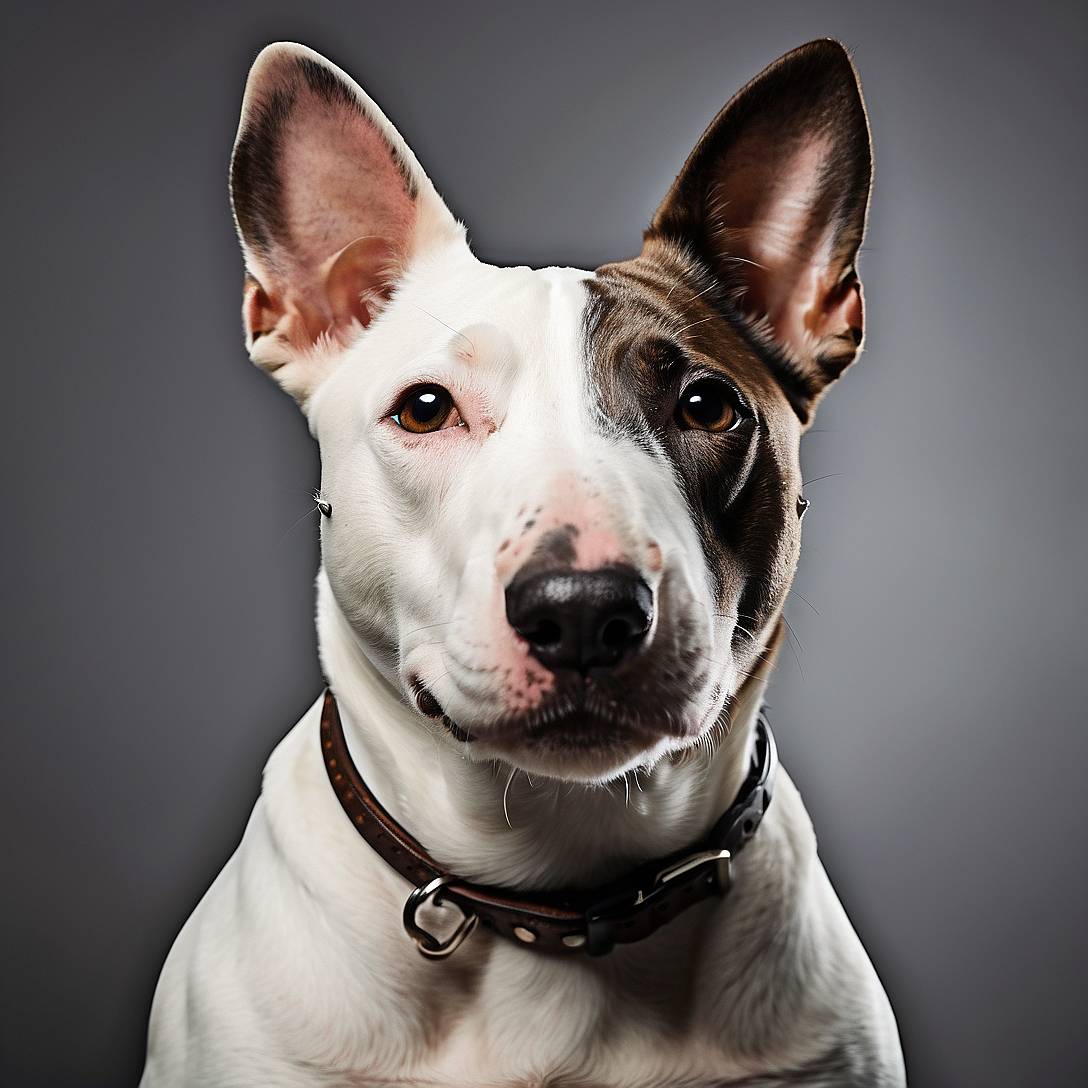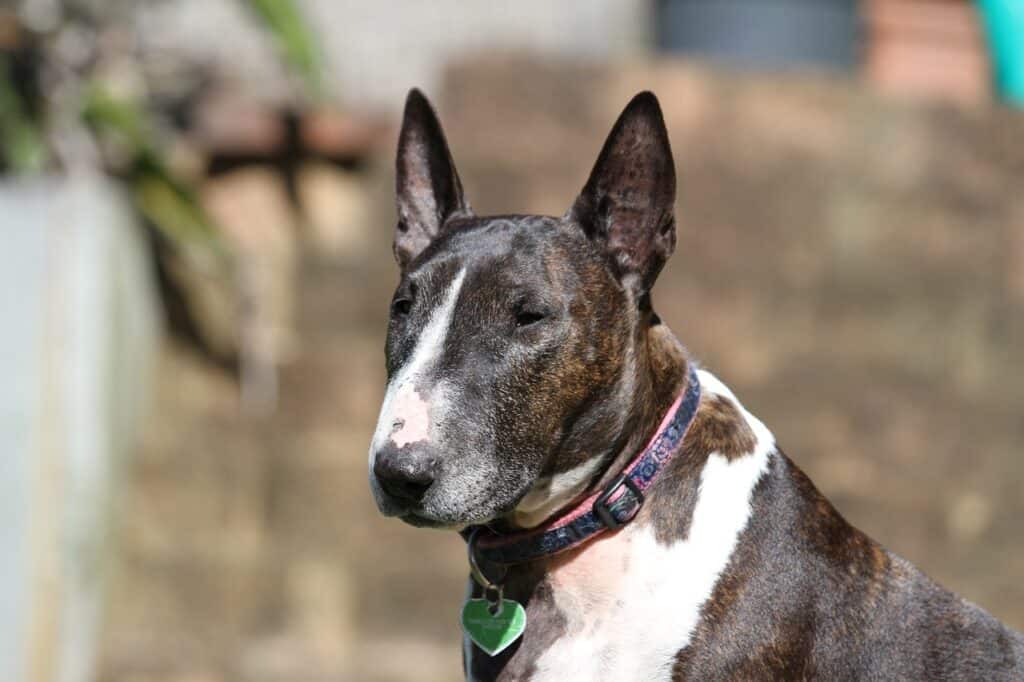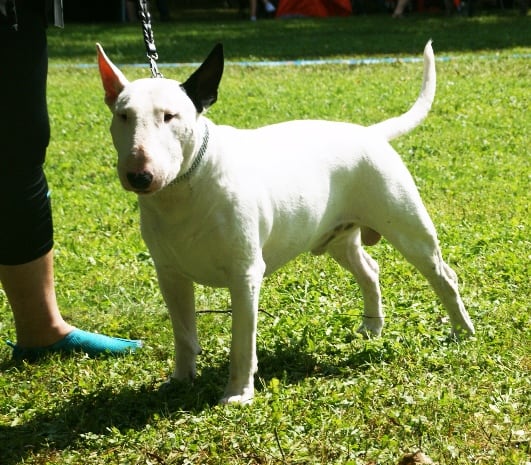The Bull Terrier, recognized for its distinctive egg-shaped head and muscular build, is a charismatic and spirited breed. With a playful and affectionate nature, this terrier is known for forming strong bonds with its family. Its unique appearance and lively personality make it a cherished pet for those who appreciate a blend of charm and energy in their canine companions.

| Category (Explanation) | Breed Information |
|---|---|
| Year of Breed Conception | 19th century |
| Country of Origin | England |
| Weight (lbs & kg) (Male) | 55-70 lbs (25-32 kg) |
| Weight (lbs & kg) (Female) | 45-55 lbs (20-25 kg) |
| Coat Type | Short and dense |
| Color Variations | White, brindle, fawn |
| Shedding Level (Low, Moderate, High) | Low |
| Height (cm & in) | 21-22 inches (53-56 cm) |
| Breed Size | Medium |
| Trainability (Low, Moderate, High) | Moderate |
| Mental Needs (Low, Moderate, High) | Moderate |
| Intelligence Level (Low, Moderate, High) | Moderate |
| Energy Level (Low, Moderate, High) | High |
| Agility (Low, Moderate, High) | Moderate |
| Loyalty (Low, Moderate, High) | High |
| Playfulness (Low, Moderate, High) | High |
| Exercise Needs | Regular exercise and playtime |
| Guarding Proficiency (Low, Moderate, High) | Moderate |
| Sociability with Children (Low, Moderate, High) | High |
| Barking Level (Low, Moderate, High) | Moderate |
| Digging Tendency (Low, Moderate, High) | Low |
| Destructive Behavior (Low, Moderate, High) | Moderate |
| Drooling Level (Low, Moderate, High) | Low |
| Obedience Level (Low, Moderate, High) | Moderate |
| Apartment Friendly (Yes/No) | Can adapt to apartment living with sufficient exercise |
| Inherent Prey Drive | Moderate |
| Physical Risk to Others (Low, Moderate, High) | Moderate |
| Travel Fatality Risk (Low, Moderate, High) | Low |
| Allergen Potential | Low |
| Health Concerns (List of Common Health Concerns) | Heart issues, skin conditions, deafness |
| Average Life Expectancy (Life Expectancy in Years) | 10-14 years |
Woof Mastery is reader supported and our articles may contain affiliate links.
Instead of running third party ads that we have no control of we only use links from high-quality companies we are directly partnered with. Making use of these links come at no cost to you our reader, and in many cases have the extra benefit of discounted rates or sign up bonuses.
If you’re interested you can read more about our affiliate policy here.
We appreciate your support and always insure that the products and services we recommend are high-quality, helpful and relevant to the subject at hand!
The Bull Terrier traces its roots back to 19th-century England, where it was developed by crossing Bulldogs with various terriers. Initially bred for dog fighting, its appearance and temperament were refined over time. James Hinks, a prominent breeder, played a pivotal role in shaping the breed into the distinctive “white cavalier” variety. The English Bull Terrier’s courage and tenacity made it popular, and it eventually transitioned into a beloved companion, appreciated for its loyalty and affectionate nature.

The Bull Terrier is distinguished by its unique egg-shaped head and muscular build. Known for its courage and tenacity, this breed possesses a playful and affectionate nature. What makes it special is the balance between its strong exterior and its loving heart. The English Bull Terrier’s devotion to its family, coupled with its distinctive appearance, sets it apart as a charming and loyal companion, offering both strength and affection in one delightful package.
The Bull Terrier’s traditional role dates back to 19th-century England, where it was initially bred for dog fighting. Over time, its appearance and temperament were refined, leading to its transition from a fighting dog to a cherished companion. The English Bull Terrier’s courage and tenacity, coupled with its playful nature, made it a popular choice as both a working terrier and a loyal family pet. Today, it continues its traditional role as a spirited and affectionate companion, embodying the balance between strength and devotion.
Bull Terriers have a distinctive appearance and a personality to match. They are known for their courage, tenacity, and playful nature. Despite their initial history in dog fighting, they have transitioned into affectionate and spirited companions. Bull Terriers are often described as clownish due to their playful antics. They are devoted to their families and can form strong bonds with children. With consistent training and socialization, they become loving and dependable family members, showcasing a unique blend of strength, loyalty, and a charming sense of humor.
Bull Terriers are known for their courage and loyalty. However, if not properly managed through training and socialization, they can display stubbornness and assertiveness. Their strength and muscular build require consistent leash training. While they are affectionate with their families, some individuals may exhibit dominance tendencies, making early training and socialization crucial. Supervision is recommended, especially around other dogs, as Bull Terriers can be selective in their interactions. With proper guidance and positive reinforcement, Bull Terriers can develop a well-adjusted temperament, combining strength with a loving nature.
Bull Terriers have a unique and muscular build with a distinctive egg-shaped head. Their head is long, flat on top, and slopes down to the nose. They have small, triangular eyes that are dark and piercing, and their ears are small and erect. The breed is known for its well-arched neck, deep chest, and short, smooth coat. Bull Terriers have a strong and straight back, with a tail that is carried horizontally. Their coat comes in various colors, including white, brindle, fawn, red, or a combination of these. Overall, Bull Terriers have a bold and athletic appearance.
Bull Terriers come in various color variations, contributing to their bold and unique appearance. The most common color variations for English Bull Terriers include:
Bull Terriers can have various coat patterns and colors. Common coat patterns include solid, brindle, piebald, ticked, and merle. Solid Bull Terriers have a single, consistent color throughout their coat. Brindle patterns consist of dark stripes on a lighter background. Piebald Bull Terriers have large, irregular patches of color on a white background. Ticked coat patterns involve small, distinct flecks or spots of color on a white background. Merle patterns feature irregular patches with a marbled or speckled appearance. The breed’s distinctive egg-shaped head and muscular build are key features regardless of coat pattern.
Bull Terriers have a low shedding level. Their short, smooth coat sheds minimally, making them relatively easy to groom. Regular brushing with a soft bristle brush helps remove loose fur and keeps the coat in good condition. While English Bull Terriers are not heavy shedders, basic grooming practices are important to promote a healthy coat and minimize shedding.
Bull Terriers have a short, dense coat that is relatively easy to maintain.
Brushing: Regular brushing, about once or twice a week, helps remove loose hair and keeps their coat healthy. Use a soft bristle brush or grooming mitt suitable for their coat type.
Bathing: Bathe as needed, typically when they get dirty. Use a mild dog shampoo to maintain a healthy coat. Be sure to rinse thoroughly and dry completely after bathing.
Ears: Check and clean their ears regularly to prevent wax buildup or infections. Use a damp cotton ball or a veterinarian-recommended ear cleaning solution.
Nails: Keep their nails trimmed regularly to prevent discomfort or issues with their gait.
Teeth: Brush their teeth regularly to promote good oral hygiene. Dental chews or toys can also be beneficial.
Bull Terriers have a moderate to high activity level. These strong and muscular dogs enjoy regular exercise, including walks, playtime, and activities that challenge them physically. Bull Terriers also benefit from mental stimulation through training sessions and interactive toys. Providing a balanced routine that includes both physical and mental engagement is important for their well-being.
Bull Terriers are known for their independent thinking and determination. While they may exhibit a stubborn streak, they are intelligent and respond well to consistent training methods. Their problem-solving skills and alert nature contribute to their adaptability in different environments. Building a strong bond through positive reinforcement enhances their trainability.
Bull Terriers thrive on mental stimulation. Engage them in activities like puzzle toys, interactive games, and obedience training to keep their minds sharp and prevent boredom.
Social Interaction: They are social dogs and need regular interaction with their family. Loneliness can lead to anxiety, so provide companionship and attention.
Exercise: Regular physical activity is important for their mental and physical well-being. Daily walks and playtime contribute to their overall health.
Enter The Woof Mastery

Before welcoming a Bull Terrier into your home, consider the following:
Bull Terriers, known for their playful nature, may exhibit boisterous behavior. Proper socialization and training from an early age can help mitigate any potential risk. Owners should be aware of their energy levels and take necessary precautions in public settings to ensure they do not unintentionally cause harm.
Bull Terriers, known for their playful nature, can be good companions for children. Supervision is important, especially with younger children, to manage their energetic play. Proper socialization from an early age is essential to ensure they interact well with children. Obedience training can help curb any exuberant behavior, and they may form strong bonds with the kids in their family.
Bull Terriers may have mixed responses to water. Some individuals may enjoy swimming, while others may not be as comfortable. Introduce them to water slowly and provide positive reinforcement. Use a canine life vest if needed, especially in situations where they may be at risk of fatigue or disorientation.
Remember that English Bull Terrier puppies, like all puppies, are eager to please and learn. Positive and consistent training practices will help them become well-behaved, obedient, and happy adult dogs. Building a strong and trusting bond with your puppy through training is a rewarding experience for both you and your canine companion.
Bull Terriers may exhibit moderate barking tendencies. They are known for being energetic and playful, and they may bark to express excitement or when they are stimulated. Proper training and socialization from a young age can help in controlling their barking behavior.
Bull Terriers do well in homes with owners who can provide consistent training and regular exercise. They adapt to various living conditions, including apartments, but they need space to move. Early socialization is crucial to prevent aggressive behavior. Positive reinforcement training is effective in shaping their behavior.
Traveling with Bull Terriers may involve considerations for their size and energy levels. Use a suitable travel crate or restraint to ensure their safety. Adequate breaks are essential for stretching and bathroom breaks. Address any potential anxiety during travel through positive associations and familiar items. If flying, choose airlines with policies accommodating their size and adhere to crate requirements for air travel.
Bull Terriers, like many breeds, may be prone to specific health concerns. While not all individuals will experience these issues, it’s essential for Bull Terrier owners to be aware of potential health problems and collaborate with veterinarians for their pets’ well-being. Common health concerns in Bull Terriers include:
Regular veterinary check-ups, a balanced diet, proper exercise, and responsible breeding practices can help mitigate some of these health concerns. It’s crucial for Bull Terrier owners to work closely with their veterinarians to monitor their pets’ health and address any issues promptly.
Proper nutrition is essential for the health and well-being of Bull Terriers. Here are some nutritional habits and best practices to consider for this breed:
Breed-Specific Laws (BSL): Bull Terriers may be subject to breed-specific laws (BSL) in certain areas. These laws are often enacted at the local or municipal level and can vary widely from one jurisdiction to another.
Types of Restrictions: The specific restrictions imposed on Bull Terriers under BSL can include mandatory spaying/neutering, special licensing, liability insurance requirements, muzzling in public, and, in some cases, bans on ownership. The severity of these restrictions depends on local regulations.
Rationale for BSL: BSL is typically implemented based on concerns about public safety and perceived risks associated with specific breeds, often due to incidents involving dog attacks. While Bull Terriers are not inherently aggressive, they can be affected by BSL due to their physical resemblance to breeds that are sometimes included in these laws.
Controversy: It’s important to note that BSL is a controversial topic. Critics argue that it unfairly targets breeds rather than addressing individual dog behavior and that responsible ownership and training should be emphasized instead of breed-specific restrictions.
Local Regulations: To determine if there are breed-specific laws or restrictions regarding Bull Terriers in your area, you should check with your local animal control or government authorities. Be aware of and comply with any local regulations to ensure that you are in compliance with the law while owning an English Bull Terrier.
Woof Mastery is reader supported and our articles may contain affiliate links.
Instead of running third party ads that we have no control of we only use links from high-quality companies we are directly partnered with. Making use of these links come at no cost to you our reader, and in many cases have the extra benefit of discounted rates or sign up bonuses.
If you’re interested you can read more about our affiliate policy here.
We appreciate your support and always insure that the products and services we recommend are high-quality, helpful and relevant to the subject at hand!
Myth 1: Bull Terriers are Aggressive
Myth 2: They are Not Good with Children
Myth 3: They are Stubborn and Hard to Train
Myth 4: They are Dangerous Due to Their Appearance
Myth 5: They Require Excessive Exercise
Myth 6: They are Not Suitable for Families
Myth 7: They are Not Good with Other Pets
Myth 8: They are Prone to Health Issues
Myth 9: They are All the Same
Myth 10: They are Always Hyperactive
Understanding the true nature of Bull Terriers and addressing misconceptions is essential for responsible ownership. These dogs can thrive as loving and well-behaved companions when provided with proper care and training.
Famous English Bull Terrier owners include:
The Bull Terrier is culturally significant as a breed with a distinctive appearance and a rich history. Known for their muscular build and egg-shaped head, Bull Terriers have made appearances in art, literature, and popular media. They are recognized for their loyalty and have become symbols of strength and tenacity. English Bull Terriers have left an imprint in cultural narratives, both as beloved companions and as iconic figures in various forms of expression.
The Bull Terrier, known for its unique egg-shaped head, gained popularity in the 19th century. While there may not be a single most famous historical owner, English Bull Terriers were favored for their distinctive appearance and loyal nature.
Bull Terriers, like many dog breeds, have faced challenges and considerations. Some of the significant challenges include:
The Bull Terrier is a distinctive breed with a history involving the combination of Bulldog and various terrier breeds. Contributing breeds may include:
Bull Terriers are distinctive and charismatic companions that bring joy and energy to every home. With their playful and affectionate nature, they easily become cherished family members. Their unique appearance and spirited personality make them stand out, and their adaptability to different living conditions ensures they fit well into diverse households. Engaging in activities that stimulate their minds and bodies enhances their well-being and strengthens the bond they form with their families.